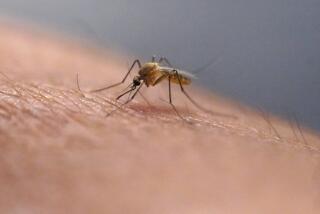Taking the Bite Out of Mosquitoes : Disease: Because some parasites in the tropics have become resistant to medication used in treating malaria, old methods of avoidance again are being recommended.
- Share via
Preventing malaria used to be simple. You took a pill, usually chloroquine, once a week and practically dared mosquitoes to bite you. Not any more. In many parts of the tropics, malaria parasites have become resistant to medication.
Taking medication is still important. But more important is not getting bitten in the first place. This involves knowing when mosquitoes are likely to bite, wearing proper clothing, using insect repellents and, where necessary, sleeping under mosquito netting.
Malaria is present in rural areas of Mexico, Central and South America, Haiti and the Dominican Republic, sub-Saharan Africa, Southeast Asia and the Indian subcontinent, and on some islands of the South Pacific.
Malaria precautions aren’t necessary for all travel to these areas. Check your itinerary with the U.S. Public Health Service--(404) 639-1610--or with physicians who specialize in tropical diseases.
Several precautions can be taken:
--Venture into rural or low-lying areas during the day and retreat to cities and relatively higher altitudes at night.
--Remain indoors at night when mosquitoes do most of their biting. The worst time to be out is twilight. Avoid evening cocktail parties at poolside or swimming after sundown.
--Wear garments with high necklines, long sleeves and long pants. Make sure they fit snugly around the neck, wrists and ankles. Avoid sheer fabrics; mosquitoes can bite through them. Dark colors may be better than bright, light ones.
--Avoid shiny jewelry, perfumes, after-shave lotion and similar substances. These can attract mosquitoes.
--Wear shoes and high socks. Stay away from sandals or open shoes. Never go barefooted.
--Never leave clothing on the ground. If you do, shake it vigorously before putting it back on.
--Use insect repellents on exposed parts of the body, especially around the neck, wrists and ankles, to prevent mosquitoes from crawling into your clothing. Generally, the best repellents are ones that contain diethyl-toluamide (DEET), but ask locally. Mosquito resistance to repellents varies.
Read labels carefully and follow directions. Repellents are formulated for specific purposes: to put on skin, to spray on clothes, to spray rooms, and to spray outdoor areas. Certain repellents are harmful to animals or plants, others can dissolve watch crystals and damage plastic eyeglass lenses.
Sensitivity reactions to DEET are rare and usually due to the repellent having too high of a concentration of DEET. Take care when using on the skin of young children and when applying to skin with sores and abrasions. If redness and itching occur, wash off with soap and water.
Perspiration decreases the effectiveness of repellents. In very hot weather and when you sweat profusely, a repellent should be reapplied every two hours.
Apply repellent by pouring or spraying it into the palms of your hands, rubbing your palms together and then applying it uniformly to exposed skin. Apply sparingly to the forehead. Too much repellent mixes with perspiration and may run into your eyes, causing irritation.
Many mosquitoes fly near the ground and bite around the ankles. The World Health Organization suggests wearing anklets dipped in insect repellent. Use cotton cloth strips about two to three inches wide. One strip is effective for several weeks.
Air-conditioned sleeping quarters with tightly fitting windows offer good protection. Elsewhere, consider sleeping under netting.
Netting should tuck well under the mattress. Rectangular-shaped netting is more effective than the more common conical shape. It provides more room to sit up, and reduces the chances of your body coming in contact with the net or mosquitoes biting through the net from the outside. The WHO suggests dipping the netting in insect repellent for additional protection.
A portable, rectangular net, LaMosquette, is available from IAMAT, the International Association for Medical Assistance to Travelers, 417 Center St., Lewiston, N.Y. 14092. Price: $75 plus mailing costs.
More to Read
Sign up for The Wild
We’ll help you find the best places to hike, bike and run, as well as the perfect silent spots for meditation and yoga.
You may occasionally receive promotional content from the Los Angeles Times.





